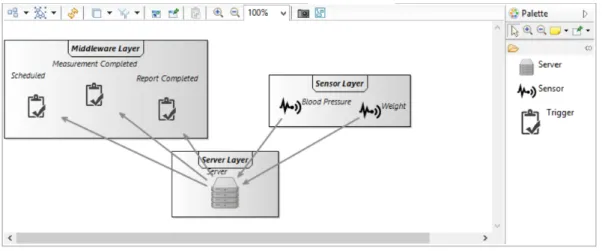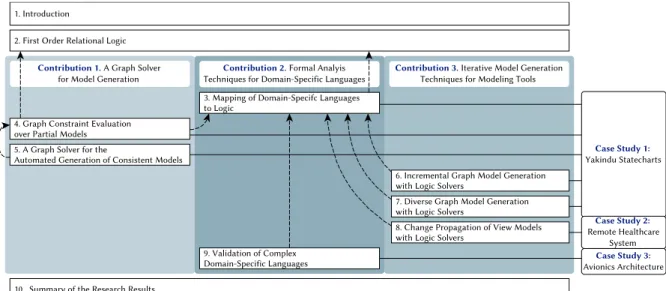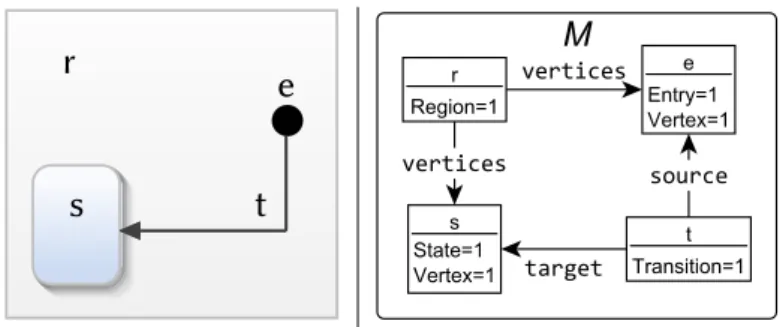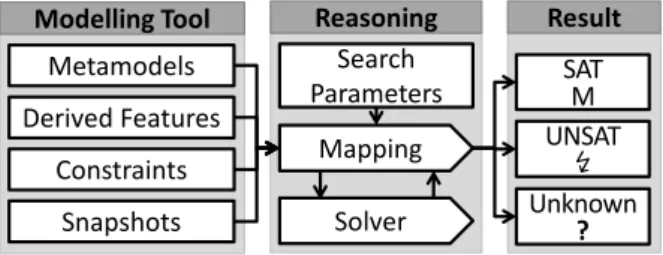In addition, my research was partially supported by grants UNKP-17-3-III New National Excellence Program of the Ministry of Human Capacities and Schnell László Foundation. Graph-based models are widely used in the development of complex, security, and business-critical systems such as automotive, avionics, and financial software.
Domain-specific modeling languages
Towards the validation of modeling environments
First, the language specification of a DSL is based on a Metamodel (MM), which defines the main concepts and relationships of the language. Even if the DSL specification is sound, the implementation of the modeling tool may contain errors.
Challenges in model generation
Model Generation Challenge 1: Encoding. How to encode DSL specifications as a logic problem where solutions of the logic problem represent valid models. Similarly, abstraction and approximation are key concepts in logic solvers used for model generation (RQ4).

Research method
FAM represents an abstraction of avionics functions, including their functional decomposition and their corresponding information connections (data flow structure) from a Simulink model. A view of the medical application is shown in Figure 1.5, which represents the data flow abstraction of the architecture for a smartphone-monitored heart rate and blood pressure measurement environment.
![Figure 1.3: Example chassis platform description from Trans-IMA [Hor+14]](https://thumb-eu.123doks.com/thumbv2/9dokorg/2497384.294255/19.892.277.626.299.527/figure-example-chassis-platform-description-trans-ima-hor.webp)
Contribution overview and thesis structure
Finally, Chapter 10 summarizes the results of the thesis and formally mentions the contributions of my work. The notation of the chapter is based on articles [C5] and [C6], but follows classical logic introductions such as [MM16].
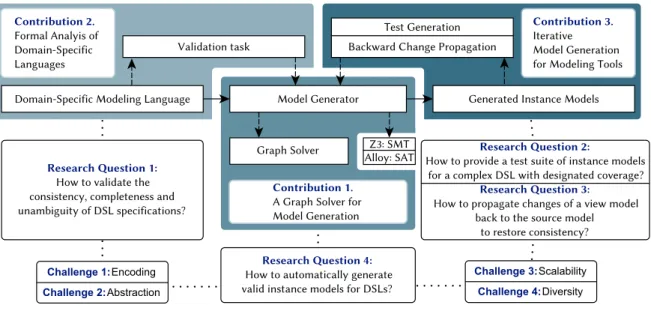
Semantics of relational logic
A variable binding maps each free expression variable to a boolean structure object. If the structure M does not satisfy (or, in other words, violates) the formula φ or the theory T, we denote it by M ̸|=φ and M ̸|=T.
Restrictions of relational logic
Extensions of relational logic
The following logical expression means that the parent of the root itself is:φ:=parent(root) ∼root. To represent this problem in relational logic, replace parentandroot with Rouderbinary and Rrootunary relation, and add the following statements to the problem:.
Summary
A metamodel MM = ⟨DMM,SMM⟩defines the main concepts, relationships of the target domain (DMM), and specifies the basic structure of the models (SMM). In a logical structureM = ⟨OM,IM⟩represent a model, OM denotes the objects and values of primitive data types (i.e. the nodes of the graph structure), and IM represents both the types of objects and the relationships between them (i.e. both node labels and edges with edge labels).

Transformation overview
This section provides a high-level functional overview of the DSL analysis approach using a basic logic solver. If the validation is successful, then the candidate model is valid in the context of the original problem, otherwise the process fails with unknown.
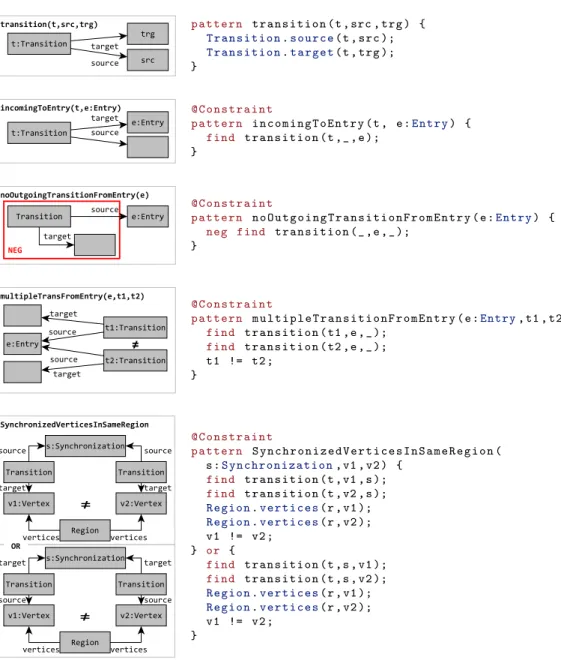
Transforming metamodels and partial snapshots
For EMF models, we allow directed loops for references and do not allow parallel edges of the same type between the same objects. Attributes are transformed in the same way as relationships, but the second parameter (i.e., the target) of the parameter defines the data type of the attribute.
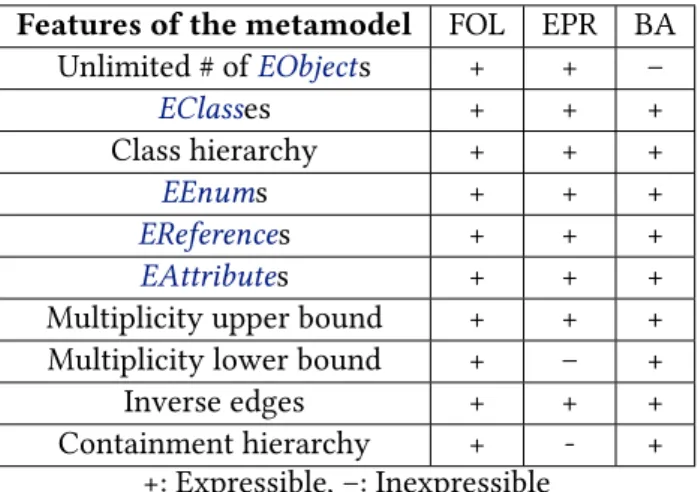
Transforming constraints to first order logic
A positive call defines that the substituted parameters must match the referenced pattern. A check constraint specifies that the result of the evaluation must be true for any valid match.

Summary
Our objective is to evaluate well-formedness constraints on partial models with graph pattern matching instead of the SAT/SMT solution, which presents some conceptual challenges. In the chapter, we propose (i) a new partial modeling formalism based on 3-valued logic [Kle+52], (ii) a mapping of a popular partial modeling technique called MAVO [FSC12a] to 3-valued partial models, and (iii) a new technique that rewrites the original graph (of model-partitioned constraints) in two. Partial models with 3 values.
Motivating example: Validation of partial models
Our approach is built on top of common modeling technologies: partial models are represented in the Eclipse Modeling Framework [Emf], annotated according to [FSC12a], well-formedness constraints are captured as graphical queries [Ber+11]. The rest of this chapter is structured as follows: Section 4.2 summarizes the basic modeling concepts of partial models and queries in the context of a motivational case.
Formalism of 3-valued partial models with interpreted equivalence and existence
In the context of DSLs, ref respects the information order of type, reference, equivalence, and existence predicates. For three-valued partial models, we use restricted syntax of first-order logic predicates, which do not use simple equivalence checks.

Rewriting predicates
The following example illustrates the steps of rewriting an example graph shown earlier in Figure 5.2 into a may predicate. Finally, the predicates may[φ]andmust[φ] are traditional 2-valued predicates, which can be combined to encode 3 possible truth values:.
Transforming MAVO uncertainty to 3-valued partial models
If a model is open, it can be expanded with new objects and references in a refinement. If a possible reference would violate a structural constraint, it is not added to P, so the accuracy of the approximation can be increased by excluding only invalid extensions.
Scalability evaluation
Related work
Conclusion
This chapter aims to provide a model generation technique to automatically generate well-formed graph models with a specification defined by (1) a metamodel (graph schema), (2) a set of well-formed constraints (WF) expressed in first-order graph logic with transitive closure, and optionally (3) an initial model fragment. The chapter is structured as follows: Section 5.2 discusses the conceptual background for partial model refinement.
Modeling preliminaries
Note that the refinement step P1 ⊑P2 will illustrate the decision rule, while P2 ⊑ P3 will illustrate the unit expansion rule later in Section 5.3.3. P3 is a concretization of P2, which is also a refinement of P2⊑P3. As shown in Section 3.2, domain-specific WF constraints are captured by standard OCL constraints [Ocl] or by graph patterns (GPs) that are translated into first-order logic.
Automated graph generation
A derivation sequence is open if it is not closed, i.e. Pk is a partial model derived from a finite derivative sequence PO. If no further decision rules can be applied, then it backtracks to continue along the previous partial model candidate.
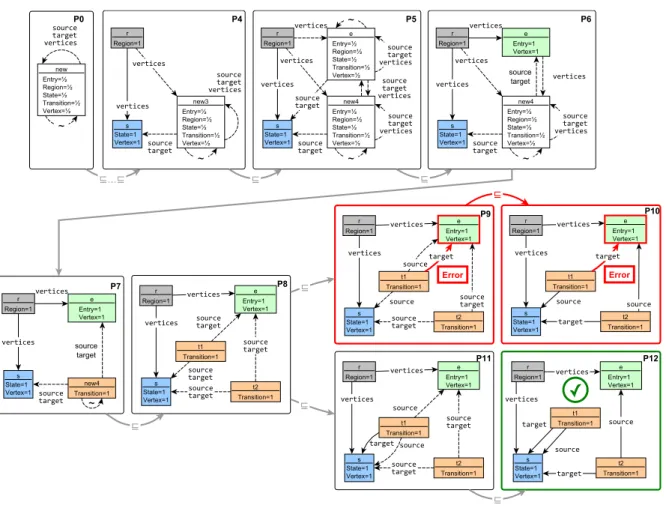
Experimental evaluation
For RQ2, we compare the model generation time of our Graph Solver with Alloy for small model sizes (from 5 to 50 features, step size of 5 new features) for the 6 test cases. Thus, the large difference in scalability in the size of generated models can probably be attributed to our graph solver.
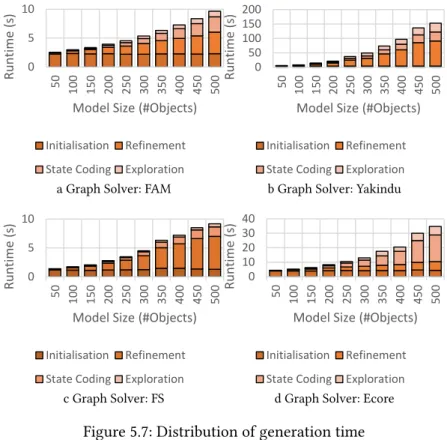
Related work
As a key difference, our approach performs model refinement while simultaneously evaluating graph query evaluation. As an important difference, our approach refines possible solutions in the form of partial models, while [SLO17; Pen08] solves the graph constraints in a concrete solution.
Conclusion
Such a difference in scalability is likely to indicate not only the advantages of our approach, but also the inherent difficulties of mapping-based modeling approaches in deriving and solving the SAT problem. Thus, our solver can serve as a result of mappings that previously used Alloy for model generation purposes.
Preliminaries
We performed experiments using the state-of-the-art Alloy Analyzer [Jac02] to determine the scalability of our approach. Our approach increases the size of generated models by carefully controlling the information that is input via abstractions and retrieved from logic solvers at each step.

Incremental model generation by approximations
If the class is not in the truncated metamodel (C < Clsp(MM)), CO(o) must be omitted, and if no new elements are created from the class, CN(o) can be omitted. If the relation is not in the reduced metamodel (R < Refp(MM)), ROO(o,t) may be omitted, and if no new elements are created from the class, RNN(o,t),RNO(o,t)andRON(o,t) may also be omitted.

Measurements
FullBy generating incremental models by combining metamodel pruning and constraint approximation, we were able to generate well-formed models for both MM1 and MM2, which was the only successful case for the latter. The combination of incremental model generation with metamodel pruning and constraint approximation is promising as a concept as it significantly improved the wrt.

Related work
Designing a model generation problem in Alloy and running the alloy analyzer by itself is likely to fail to yield useful results for practical metamodels, especially, in the presence of complex well-formation constraints. Logical solution approaches. Some approaches map a model generation problem (captured by a meta-model, partial snapshots, and a set of WF constraints) into a logic problem, which are solved by basic SAT/SMT solvers.
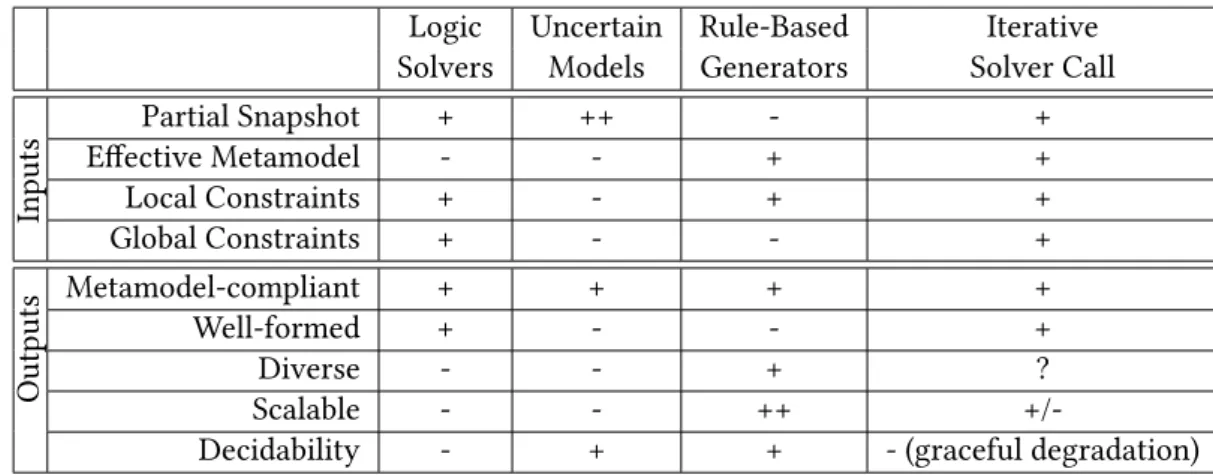
Conclusion
On the positive side, these approaches guarantee diversity of models and good scale in practice. Our finding is that a diverse set of models drawn along different neighborhood shapes has better mutation results.
Preliminaries
To that end, it is important that WF constraints and model transformations of DSL tools can be systematically tested. As an error model, we consider omission errors in WF constraints of DSL tools where some subconstraints are not actually checked.

Model diversity metrics for testing DSL tools
We will use the size of a shape|Si(M)| which is the number of shapes used in M. Moreover, given a specific rangei, the number of potential neighborhood shapes within this range is limited, but it grows superexponentially.

Evaluation
The mutation score for a set of tests (i.e. a set of models) is the total number of mutants killed in that manner. RQ3: Analysis of results. Figure 7.7 illustrates the correlation between mutation score (horizontal axis) and intrinsic diversity (vertical axis) for all generated and human models in all configurations.
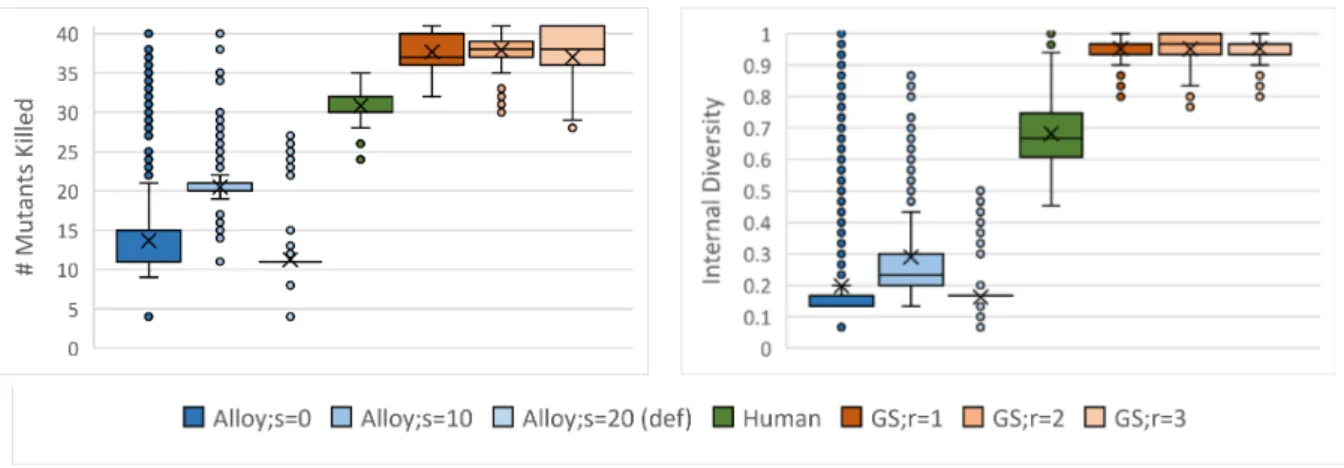
Related work
Finally, although we found a strong correlation between diversity and mutation score with our test cases, this result cannot be generalized to statistical causality because the models generated were not random samples drawn from the model universe. Therefore, further investigations are needed to substantiate this correlation, and we only argue that if the model is generated with either GS or Alloy, a higher diversity means a higher mutation result with a high probability.
Conclusion
Typically, multiple view models are defined for a given underlying source model, which must be updated automatically (or upon user request) upon changes in the source model. Using an iterative technique [C10] over the Alloy Analyzer [Jac02], our approach enumerates several (but not all) valid solutions of the source model corresponding to the changes of view models and the constraints of the source model.
View models
AddObj(C,φ)ActivationZ of preconditionφcreates an item⟨φ,Z,v⟩in the trace with a unique display object in the display model with the corresponding typeC. For the Dataflow view, srcquery selects all Measure type instances to create information type instances in the view, while srcquery is responsible for creating Host instances of the Host objects in the source model.
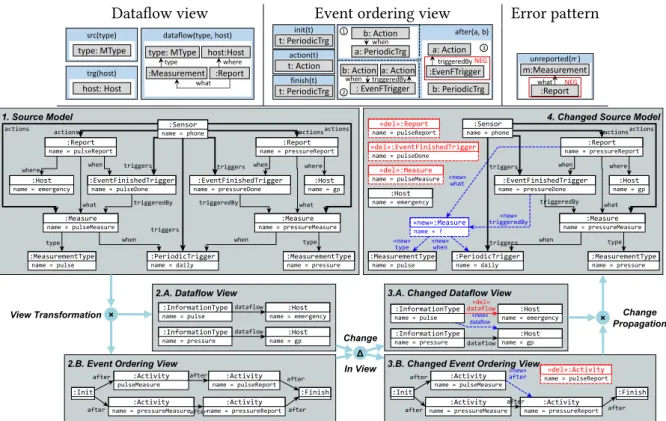
Backward change propagation by logic solvers
To ensure these conditions, an impact analysis of the changes must be performed to identify the affected part of the source model that can be changed. In general, partitioning aims to select a relatively small fragment of the source model to change in order to propagate the change back.
Experimental evaluation
The size of the target change increases the size of the source volume needed for the solution. Figure 8.7 shows the runtime of incremental and full model generation versus source model size and source scope.
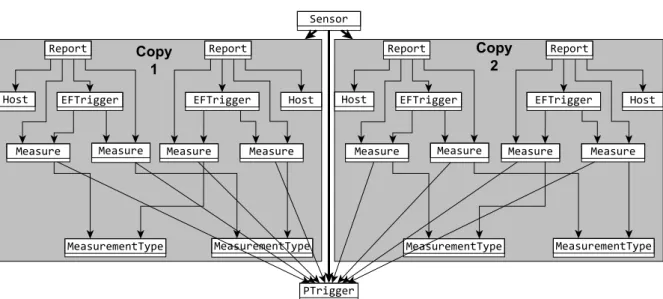
Related work
This property is supported in the specification [OMG] and [MC13] and in our approach. In addition, a particular partial patch model is determined when the target model changes using traceability links that are maintained during forward propagation.
Conclusion
In addition, a more generic problem can be efficiently solved if represented in the target scope of the backend solver. Thus, with appropriate approaches, language properties cannot be constructed directly in the target logic formalism.
Running example: Avionics modeling environment
The value of a DF can be calculated from other parts of the model as defined by a model query [RHV12; Okl]. Model query frameworks such as Viatra automatically recalculate the value of the derived features in the instance model to satisfy DF [RHV12].
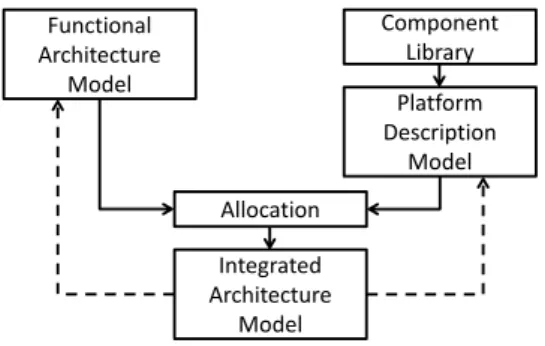
Overview of the approach
If there is a model where no values can be assigned to an instance of the derived function, it is incomplete. An output model where multiple values can be assigned to some instance of DF means that DF is ambiguous.

A case study on DSL validation
To demonstrate the subsumption check, another WF constraint is added to the DSL specification expressed by the InformationAndTerminatorquery (Figure 9.13, bottom part), which prohibits an InformationLink from being connected to a FAMTerminator. This constraint only differs from the first body of the original WF constraint (see Figure 9.5) in that it uses the reverse edges, so it is redundant.
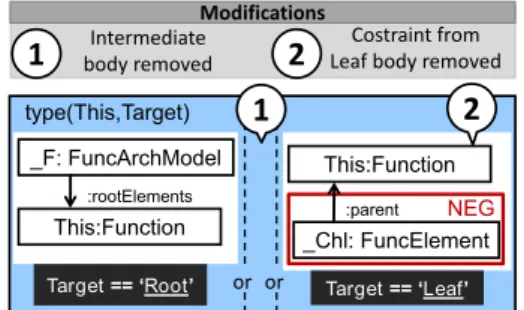
Runtime measurements
Below we only briefly demonstrate how to derive a valid model of minimum size (see Figure 9.14) which contains all the SPs from Figure 9.7. Freq-GP Wrong Frequency Figure 9.6 Freq-OCL RightFrequency Figure 9.6 Terminator and T&I-GP Information Figure 9.5 Terminator T&I-OCLNoLink Figure 9.5 Half-GP Information and Terminator Figure 9.13 negative7- Half.
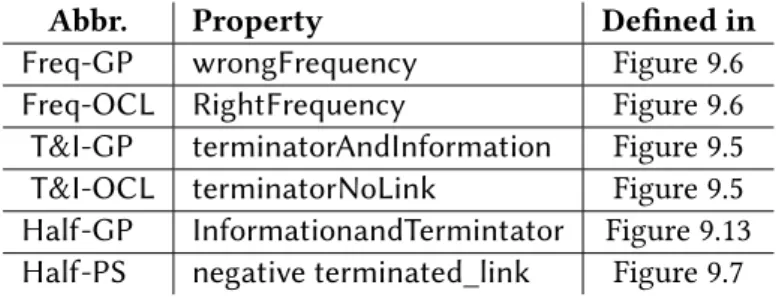
Related Work
The main difference between the Clafer and our approach is that we support EMF as our metamodeling language compared to the Clafer specification language, which is only supported by their own framework. In the case of using approaches for rich query features, our approach converges to bounded verification techniques.

Conclusion
Incremental graph query evaluation of the VIATRA engine [Ujh+15] is used to efficiently evaluate constraint violations over partial models during the model generation process. I performed experimental scalability evaluation of the graph solver in three case studies of industrial DSLs.
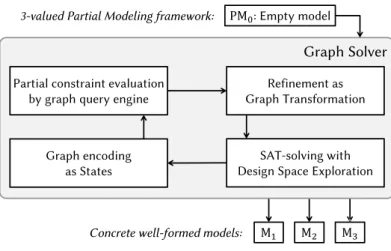
Language-level validation for domain-specific languages
I introduced a technique that uniformly translates DLS elements into FOL to analyze the consistency of the entire DSL specification, which includes metamodels, instance models, well-formedness (OCL or graph pattern), and derived features. Added value The main added value of the approach is to cover rich DSL constructs such as derived features and well-formed constraints captured in declarative languages such as graph patterns and OCL (Ch1: Encoding) invariants.
Iterative model generation techniques for modeling tools
Moreover, our model generation technique derives a structurally diverse set of models by computing the shape of the previous solutions and avoiding those shapes in the next generated model (Ch4: Diversity). With Mária Bekő we developed test Cypher query [Fra+18] generation framework for graph databases like Neo4j [Web12] using diverse model generation.
Future work
Në: Proceedings of the 21th International ACM/IEEE Conference on Model Driven Engineering Languages and Systems, MODELS 2018, Kopenhagen, Danimarkë, tetor pp. Në: Proceedings of the ACM/IEEE 19th International Conference on Model Driven Engineering Languages and Systems, France-SaintMapplo, Tetor, SaintMapplo, Tetor.
Transforming OCL invariants to first order logic
If the set can be implied by the context, the index of the set is omitted: P(x). This expression is satisfied if the elements of the collection do not satisfy the condition.

Implicit equivalence check rewriting
Partial models
Refinement operations
As a result, Pn−1 is gradually refined to aPk that no longer contains a 1⁄2 value, so it is an instance model. 3] Assume that in our calculation splitAndConnect(o,mode) has been applied in at least two modern times, so Pn contains at least n + 1 objects, while our instance model has only n objects.
Change partitioning of view models

